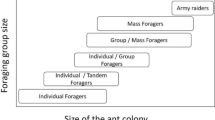Abstract
Amplifying communication is a characteristic of group-living animals. This study is concerned with food recruitment by chemical means, known to be associated with foraging in most ant colonies but also with defence or nest moving. A stochastic approach of collective choices made by ants faced with different sources is developed to account for the fluctuations inherent to the recruitment process. It has been established that ants are able to optimize their foraging by selecting the most rewarding source. Our results not only confirm that selection is the result of a trail modulation according to food quality but also show the existence of an optimal quantity of laid pheromone for which the selection of a source is at the maximum, whatever the difference between the two sources might be. In terms of colony size, large colonies more easily focus their activity on one source. Moreover, the selection of the rich source is more efficient if many individuals lay small quantities of pheromone, instead of a small group of individuals laying a higher trail amount. These properties due to the stochasticity of the recruitment process can be extended to other social phenomena in which competition between different sources of information occurs.
Similar content being viewed by others
References
Anderson, C. and D. W. McShea (2001). Individual versus social complexity, with particular reference to ant colonies. Biol. Rev. (Cambridge) 76, 211–237.
Beckers, R., J. L. Deneubourg and S. Goss (1992a). Trail laying behavior during food recruitment in the ant Lasius niger (L.). Ins. Soc. 39, 59–72.
Beckers, R., J. L. Deneubourg and S. Goss (1992b). Trails and U-turns in the selection of a path by the ant Lasius niger. J. Theor. Biol. 159, 397–415.
Beckers, R., J. L. Deneubourg and S. Goss (1993). Modulation of trail laying in the ant Lasius niger (Hymenoptera: Formicidae) and its role in the collective selection of a food source. J. Insect Behav. 6, 751–759.
Beckers, R., S. Goss, J. L. Deneubourg and J. M. Pasteels (1989). Colony size, communication and ant foraging strategy. Psyche (Stuttg) 96, 239–256.
Beekman, M., D. J. T. Sumpter and F. L. W. Ratnieks (2001). A phase transition between disordered and ordered foraging in Pharoah’s ants. Proc. Natl Acad. Sci. USA 98, 9703–9706.
Bonabeau, E., M. Dorigo and G. Theraulaz (1999). Swarm Intelligence: From Natural to Artificial Systems, Oxford University Press.
Camazine, S., J. L. Deneubourg, N. R. Franks, J. Sneyd, E. Bonabeau and G. Theraulaz (2001). Self-organized Biological Superstructures, Princeton: Princeton University Press.
Camazine, S. and J. Sneyd (1991). A model of collective nectar source selection by honeybees. Self-organization through simple rules. J. Theor. Biol. 149, 547–571.
Costa, J. T. and R. W. Louque (2001). Group foraging and trail following behavior of the red-headed pine sawfly Neodiprion lecontei (Fitch) (Hymenoptera: Symphyta: Diprionidae). Ann. Entomol. Soc. Am. 94, 480–489.
Deneubourg, J. L., S. Aron, S. Goss and J. M. Pasteels (1990). The self-organizing exploratory pattern of the Argentine ant. J. Insect. Behav. 3, 159–168.
Detrain, C., J. L. Deneubourg and J. M. Pasteels (1999). Information Processing in Social Insects, Basel: Birkhäuser Verlag.
Edelstein-Keshet, L. (1994). Simple models for trail-following behavior: trunk trails versus individual foragers. J. Math. Biol. 32, 303–328.
Fitzgerald, T. D. (1995). The Tent Caterpillars, Ithaca: Cornell University Press.
Geissles, O. and F. Roces (2001). Crop-loading dynamics in the nectar-feeding ant Camponotus rufipes: effects of foraging experience, food quality and colony starvation, in Proceedings of the Meeting UIEIS (European Sections) 27.
Gillespie, D. T. (1992). Markov Processes, San Diego: Academic Press.
Hangartner, W. (1969). Structure and variability of the individual odor trail in Solenopsis geminata Fabr. (Hymenoptera, Formicidae). Z. Vgl. Physiol 62, 111–120.
Hölldobler, B. and E. O. Wilson (1991). The Ants, Berlin: Springer.
Lioni, A., C. Sauwens, G. Theraulaz and J. L. Deneubourg (2001). Chain formation in Oecophylla longinoda. J. Insect Behav. 14, 679–696.
Mailleux, A. C., C. Detrain and J. L. Deneubourg (2000). How do ants assess food volume? Anim. Behav. 59, 1061–1069.
Miller, D. M. and P. G. Koehler (2000). Trail-following behavior in the German cockroach (Dictyoptera: Blattellidae). J. Econ. Entomol. 93, 1241–1246.
Nicolis, S. C. and J. L. Deneubourg (1999). Emerging patterns and food recruitments in ants: an analytical study. J. Theor. Biol. 198, 575–592.
Rivault, C., G. Theraulaz, A. Cloarec and J. L. Deneubourg (1999). Auto-organization et reconnaissance coloniale: le modèle de l’agrégation des blattes. Actes Colloques Insectes Sociaux Section française, Albi 1998.
Ruf, C., J. T. Costa and K. Fiedler (2001). Trail-based communication in social caterpillars of Eriogaster lanestris (Lepidoptera: Lasiocampidae). J. Insect Behav. 14, 231–245.
Seeley, T. D. (1995). The Wisdom of the Hive, Cambridge: Harvard University Press.
Seeley, T. D., S. Camazine and J. Sneyd (1991). Collective decision-making in honeybees: how colonies choose among nectar sources. Behav. Ecol. Sociobiol. 28, 277–290.
Stickland, T., N. F. Britton and N. R. Franks (1995). Complex trails and simple algorithms in ant foraging. Proc. R. Soc. Lond. B 260, 53–58.
Theraulaz, G. and F. Spitz (1997). Auto-organisation et Comportement, Hermes Editions.
Traniello, J. F. A. and S. K. Robson (1995). Trail and territorial pheromones in the social insects, in The Chemical Ecology of Insects, Vol. II, Chapter 7, W. J. Bell and R. Cardé (Eds), Chapman & Hall, pp. 241–285.
van Kampen, N. G. (1981). Stochastic Processes in Physics and Chemistry, Amsterdam: North-Holland.
Visscher, P. K. and S. Camazine (1999). Collective decisions and cognition in bees. Nature 397, 400.
Author information
Authors and Affiliations
Corresponding author
Rights and permissions
About this article
Cite this article
Nicolis, S.C., Detrain, C., Demolin, D. et al. Optimality of collective choices: A stochastic approach. Bull. Math. Biol. 65, 795–808 (2003). https://doi.org/10.1016/S0092-8240(03)00040-5
Received:
Accepted:
Issue Date:
DOI: https://doi.org/10.1016/S0092-8240(03)00040-5




